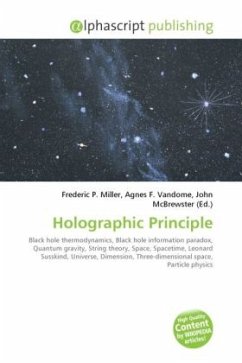High Quality Content by WIKIPEDIA articles! The holographic principle is a property of quantum gravity and string theories which states that the description of a volume of space can be thought of as encoded on a boundary to the region preferably a light-like boundary like a gravitational horizon. First proposed by Gerard 't Hooft, it was given a precise string-theory interpretation by Leonard Susskind. In a larger and more speculative sense, the theory suggests that the entire universe can be seen as a two-dimensional information structure "painted" on the cosmological horizon, such that the three dimensions we observe are only an effective description at macroscopic scales and at low energies. Cosmological holography has not been made mathematically precise, partly because the cosmological horizon has a finite area and grows with time. The holographic principle was inspired by black hole thermodynamics, which implies that the maximal entropy in any region scales with the radius squared, and not cubed as might be expected. In the case of a black hole, the insight was that the description of all the objects which have fallen in can be entirely contained in surface fluctuations of the event horizon.








